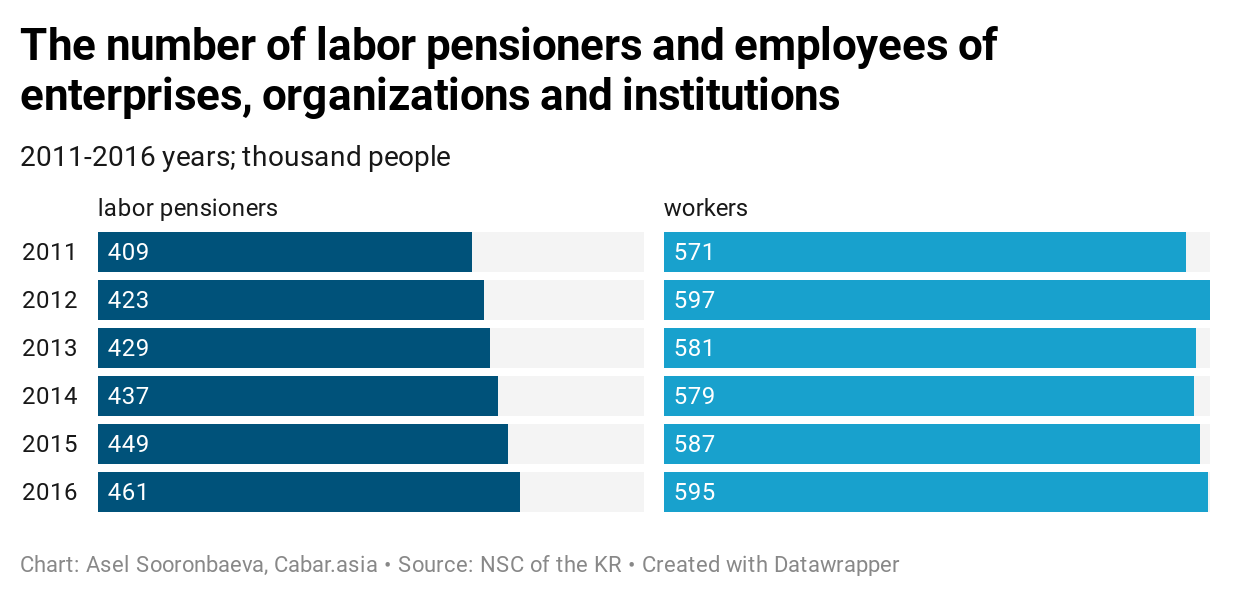It’s not easy to understand how the Social Fund of the Kyrgyz Republic calculates the amount of pension.
According to the National Statistical Committee, Kyrgyzstan has around 673 thousand pensioners of various categories. Almost every fourth of them has a pension that is below the living wage; in 2017 the living wage was estimated at 4,900 soms.

In Kyrgyzstan, the law “On national pension social insurance” provides that the state pension age is 63 for men and 58 for women. The old-age pension is payable to all persons regardless of whether they paid insurance contributions to the Social Fund or not. According to the National Statistical Committee, old-age pensioners in the Kyrgyz Republic account for 73 per cent of the total number of pensioners.
 Men must have 25 years of total employment in order to receive the basic pension in full. Let’s turn to our contributions to the Social Fund. Every month every employee working under contract has 10 per cent of his wage deducted as pension contributions, 10 per cent as taxes to the district office of Tax service. The employer also pays contributions for their employee – 17.25 per cent of employee’s wage (15 per cent to the Pension Fund, 2 per cent to the Compulsory Medical Insurance Fund, 0.25 per cent to the Employee Health Care Fund). Thus, the Social Fund gets 25 per cent of every employee’s wage.
Men must have 25 years of total employment in order to receive the basic pension in full. Let’s turn to our contributions to the Social Fund. Every month every employee working under contract has 10 per cent of his wage deducted as pension contributions, 10 per cent as taxes to the district office of Tax service. The employer also pays contributions for their employee – 17.25 per cent of employee’s wage (15 per cent to the Pension Fund, 2 per cent to the Compulsory Medical Insurance Fund, 0.25 per cent to the Employee Health Care Fund). Thus, the Social Fund gets 25 per cent of every employee’s wage.
 For example, a person’s wage is 15,000 soms. This amount is an average wage in Kyrgyzstan, according to the National Statistical Committee. In this case, total expenses of the employer amount to 21,712 soms. The employer allocates 18,518 soms as an employee’s wage and pays 10 per cent, or 1,851 soms to the Social Fund, and another 10 per cent (1,666 soms) of the remaining amount as an income tax to Tax Service, respectively. Also, the employer pays 3,194 soms individually to the Social Fund, which is 17.25 per cent of the employee’s wage the employer must pay at their expense to the state budget. Thus, the Social Fund gets 5,047 soms in average from every employee on a monthly basis.
For example, a person’s wage is 15,000 soms. This amount is an average wage in Kyrgyzstan, according to the National Statistical Committee. In this case, total expenses of the employer amount to 21,712 soms. The employer allocates 18,518 soms as an employee’s wage and pays 10 per cent, or 1,851 soms to the Social Fund, and another 10 per cent (1,666 soms) of the remaining amount as an income tax to Tax Service, respectively. Also, the employer pays 3,194 soms individually to the Social Fund, which is 17.25 per cent of the employee’s wage the employer must pay at their expense to the state budget. Thus, the Social Fund gets 5,047 soms in average from every employee on a monthly basis.
 The sums accumulated are distributed among all pensioners. In fact, the next generation funds the previous one, and the pension amount depends largely on the well-being of the current population, which cannot be influenced by pensioners.
The sums accumulated are distributed among all pensioners. In fact, the next generation funds the previous one, and the pension amount depends largely on the well-being of the current population, which cannot be influenced by pensioners.
 It’s no secret that many employers try to avoid taxes and hire employees without contract, whereas high unemployment rates and lack of knowledge about labour rights lead to hidden salary in most cases. Today, there’s 1.2 registered employees per one pensioner. The International Labour Organisation (ILO) recommends to triple this number, otherwise the pension system goes out of balance and starts losing its stability. If the situation does not change, in 10-12 years the current pension protection model will not be able to cover all pensioners, and the state will be at risk of losing the opportunity to pay out guaranteed pensions to citizens.
Asel Sooronbaeva – CABAR.asia School of analytic journalism alumnus
It’s no secret that many employers try to avoid taxes and hire employees without contract, whereas high unemployment rates and lack of knowledge about labour rights lead to hidden salary in most cases. Today, there’s 1.2 registered employees per one pensioner. The International Labour Organisation (ILO) recommends to triple this number, otherwise the pension system goes out of balance and starts losing its stability. If the situation does not change, in 10-12 years the current pension protection model will not be able to cover all pensioners, and the state will be at risk of losing the opportunity to pay out guaranteed pensions to citizens.
Asel Sooronbaeva – CABAR.asia School of analytic journalism alumnus
This article was prepared as part of the Giving Voice, Driving Change – from the Borderland to the Steppes Project implemented with the financial support of the Foreign Ministry of Norway.

